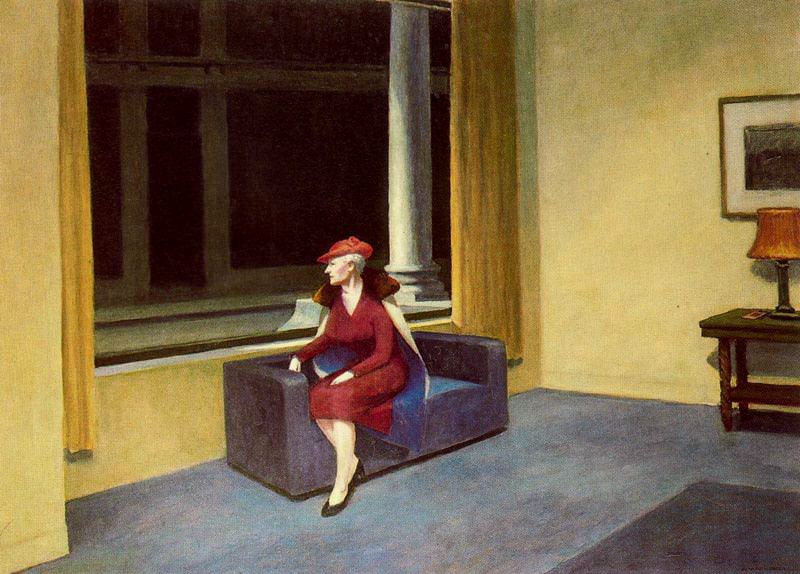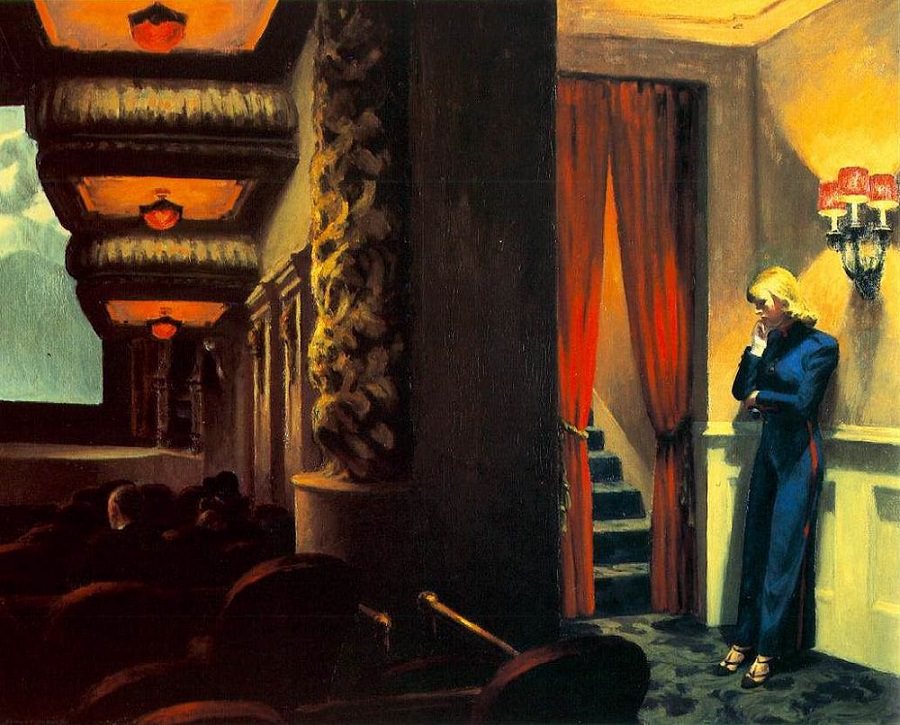The clean simplicity and the physical solidity, the wide ocean skies, the lone petrol stations, or the dark emptiness of space and time that surrounds the ‘Nighthawks’, all speak to us of the latent complexities and depths of even the most mundane moments and places. At which point does solitude become loneliness, or vice versa?
Edward Hopper is one of the most recognisable American artists of the 20th century. Whether it is the wide landscapes of the open plains or the shore, through the bold clarity of his shapes he manages to communicate the subtle interplay of space and light. He is most recognisable in his urban landscapes of New York, in the determined presence of its buildings, especially its bars and cafes peopled by women and men caught in some timeless moment of recollection or solitude. The bright, unforgiving lights and shadows of the interior often contrast with the deep blackness of the night outside. Even when he paints people in some sort of relationship – at a table, in a lounge or on a bed – there is always a sense of aloneness, space both defining and placing them while emphasising their singularity.
His paintings all have the quality of a still-life. In their urban or domestic space, caught in a moment when they are not conscious of us, his people, which could easily be static objects, manage to engage us. They are not anonymous, because they communicate an interior consciousness which we recognise but cannot access. Yet, they also draw us into their space; in all of Hopper’s paintings the viewer, too, is made conscious. The very emptiness or stillness reflects us back at ourselves, caught in the act, faced with distances and spaces in which we, too, stand. We are held in the moment of our own gaze and the artist who has caught us, like the light, is both present and yet not present – he is never absent.
In all these ways, Hopper’s paintings have a mood and an interiority; they are deceptively complex both in their composition and in their mood. The clean simplicity and the physical solidity, the wide ocean skies, the lone petrol stations, or the dark emptiness of space and time that surrounds the ‘Nighthawks’, all speak to us of the latent complexities and depths of even the most mundane moments and places. At which point does solitude become loneliness, or vice versa? Hopper’s subjects, people or buildings, all seem to have a quality of waiting. It is not always still or balanced; it can be precarious, poised before a slowly rising interior darkness or before falling into the vast interior spaces of emptiness and alienation. These landscapes of the soul are just as familiar to us as the line of our streets and the skylines of our cities.
He was always fascinated by light and towards the end of his life he painted ‘Sun in an Empty Room’. It has its own beauty. All his art and his insight are gathered here, his play with paradoxes and with the solidity of our world and the fluidity of our interior spaces. In ‘Sun in an Empty Room’, Hopper manages to paint light itself. Without light, we cannot see, and even here when it enters an empty room, we recognise that without light we cannot see the emptiness itself. Yet the room does not capture the light or contain it, rather it is filled by it. The room is given its shape and depth and interest; it is not a dead or flat surface. The light plays also in the shadows, which it creates and are part of how it illuminates. There is a sense that the room is not empty at all.

Just imagine it with some object and you will recognise that it is the object that is an intrusion, almost an act of violence disrupting the harmony and balance and distracting us from the light itself. We have a sense that the room has been waiting and wants to remain empty to receive all of the light, to be filled by it. Waiting to know itself as precisely this, an empty room with no other purpose than to be an empty room filled with light. And we are not invited in; it is almost as if Hopper wants us to respect the moment, the space, the light. We, too, are held looking and marvelling at the beauty of an empty room filled with light. Light does not displace or occupy, it indwells. The only way we can come to this moment is not as viewers but as contemplatives.
Hopper may not be a bad artist to lead us in Advent in this time of Covid. He understood the meaning of distance, the complex relationship of spaces and times, their ambiguities. How they can grow inside us and leave us with a sense of precariousness and solitude. Yet, there is something too about the ‘Sun in an Empty Room’ which illuminates another dimension: emptiness can sometimes be the condition for receiving the light itself. Waiting can also be a sort of readiness, suspended, free, open, in the stillness, holding time, listening for the light: ‘The Light shines in the darkness, and the darkness has not overcome it’.








